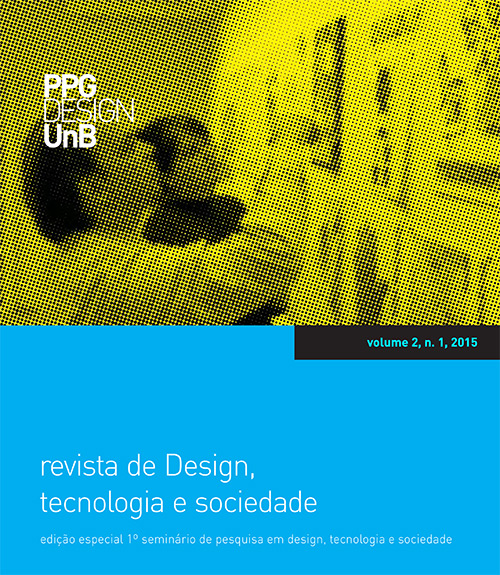Desafios do design experiencial
Mots-clés :
Design. emoção. experiênciaRésumé
Este artigo explora trajetórias do design experiencial e algumas questões sobre esse tema. Para tanto, o artigo inicia com uma breve história da interação humano-computador para situar a experiencia e segue com a revisão bibliográ ca sobre as bases teóricas do design experiencial. O resultado dessa contrução é‡ uma trajetória entre o concreto e a experiencia onde várias questões ainda precisam ser respondidas e outras elaboradas.
Téléchargements
Références
Alben, L. (Volume 3 Issue 3 de May/June de 1996 ). Quality of experience: defining the criteria for effective interaction design. Interactions , pp. 11-15.
Buxton, B. (2007). Sketching User Experiences. Morgan Kaufmann.
Carrol, J., & Thomas, J. (Janeiro de 1988). Fun. SIGCHI Bulletin , pp. 21-24.
Damásio, A. (1994). O Erro de Descartes : Emoção Razão e o Cérebro Humano. São Paulo:Companhia das Letras.
Desmet, P., & Hekkert, P. (2002). The Basis of Product Emotions. In: W. Green, & P. Jordan, Pleasure with Products, beyond usability (pp. 60-68). London: Taylor and Francis.
Hassenzahl, M. (2007). The Hedonic/Pragmatic Model of User Experience. In: E. Law, A. Vermeeren, M. Hassenzahl, & M. Blythe, Towards a Manifesto (pp. 10-14). Lancaster: Cost. Hassenzahl, M. (2003). The Thing and I: Understanding the relationship between user and products. In:K. O. by M.A. Blythe, Funology: From Usability to Enjoyment (pp. 31-42). Netherlands: Kluwer Academic Publishers.
Hassenzahl, M., & Tractinsky, N. (Março-Abril de 2006). User experience ”“ a research agenda. Behaviour & Information Technology , pp. 91-97.
Hoog, W. v., Keller, I., & Stappers, P. J. (2004). Gustbowl: technology supporting affective communication through routine ritual interactions. CHI EA ‘04 (pp. 775-776). New York: ACM. Kort, J., Vermeeren, A. P., & Fokker, J. E. (2007). Conceptualizing and Measuring UX. In: E. Law, A. Vermeeren, M. Hassenzahl, & M. Blythe, Towards a UX Manifesto (pp. 57-64). Lancaster: Cost. Millard, N., & Hole, L. (2008). In the Moodies: Using ´Affective Widgets to help Contact Centre Advisors
Fight Stress. In: C. Peter, & R. Beale, Affect and Emotion in Human-Computer Interaction (pp. 186-193). Berlin: Springer Berlin Heidelberg.
Picard, R. (2000). Affective Computing. The MIT Press. Rettig, M. (27 de Janeiro de 2008). Interaction Design History in a Teeny Litte Nutshell. Acesso em 15
de Maio de 2010, disponível em Slideshare: http://pt.slideshare.net/mrettig/interaction-designhistory Roto, V. (2007). User Experience from Product Creation Perspective. In: E. Law, A. Vermeeren, M. Hassenzahl, & M. Blythe, Towards a UX Manifesto (pp. 31-34). Lancaster: Cost.
Seligman, M., & Csikszentmihalyi, M. (Janeiro de 2000). Positive Pychology: An introduction. American Psychologist , pp. 5-14.
The Demo. (s.d.). Acesso em 07 de Maio de 2015, disponível em Mouse Site: http://web.stanford.edu/dept/SUL/library/extra4/sloan/mousesite/1968Demo
Tractinsky, N., & Zmiri, D. (Abril de 2006). Exploring attributes of skins as potential antecedents of emotion in HCI. Aesthetic computing , pp. 405-422.
Tractinsky, N., Katz, A., & Ikar, D. (Dezembro de 2000). What is beautiful is usable. Interacting with Computers , p. Interacting with Computers.
Téléchargements
Publié-e
Comment citer
Numéro
Rubrique
Licence
Declaração de Direito Autoral
Autores mantém os direitos autorais e concedem à revista o direito de primeira publicação, com o trabalho simultaneamente licenciado sob a Licença Creative Commons Attribution que permite o compartilhamento do trabalho com reconhecimento da autoria e publicação inicial nesta revista.



